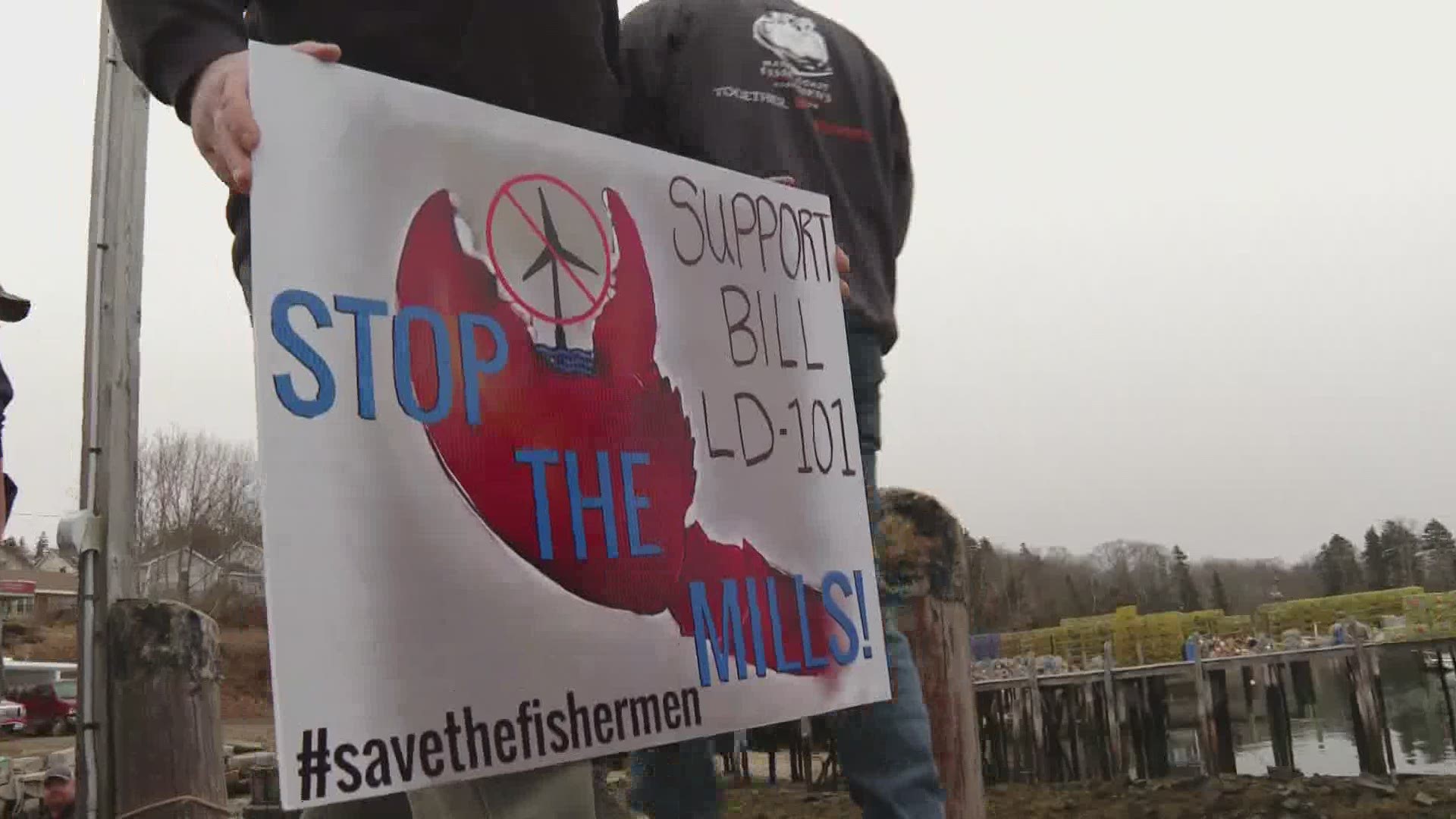FRIENDSHIP, Maine — In one of Maine’s biggest lobster harbors, close to 100 fishermen and their supporters packed the town dock to stand, side by side, in opposition to offshore wind power development in the Gulf of Maine.
They were also united in their worry about the prospect of those projects happening.
“There is so much at stake, so many livelihoods, so many families,” said George Gilbert, a lobsterman from New Harbor.
“Big business is coming to Maine, on the water, trying to industrialize our ocean with windmills. It's just a terrible idea for us.”
Offshore wind power had been talked about for a decade, urged ion, in part, by researchers at the University of Maine who developed a new design for a large, floating platform for the turbines. Over the past two years, Governor Janet Mills has been actively pushing for the development of floating offshore wind turbines as a way to provide new sources of renewable energy to help fight climate change.
At the same time, the first actual floating turbine project is moving ahead for waters off Monhegan Island. The test site was approved and designated by the Maine Legislature about 12 years ago. After some starts and stops, a partnership called New England Aqua Ventus is working to build a huge, six-megawatt wind turbine using the UMaine floating platform.
This month, special survey ships have been working the waters between Monhegan and Boothbay to map a path for the underwater cable to feed wind power to the mainland.
That activity has ramped up opposition from lobstermen. Those who fish water in the cable path say creating the trench for the cable will cause lots of underwater disturbance, which will harm lobsters and other species.
“I think the dredging process will do great harm to the eco-system on the ocean floor,” said Larry Reed, a fisherman from South Bristol who regularly sets traps in the area of the proposed cable.
They also worry the electromagnetic field from the high voltage cable could harm lobsters and other marine life near it, damaging fishing for years to come.
The leader of New England Aqua Ventus said their worries are understandable but insists the project is being planned to protest fishermen as much as possible.
“The purpose of this survey is to find large parts of the ocean floor where we can bury this cable,” said Chris Wissmann of NEAV, who said the high-pressure water used to dig the three-foot-wide trench for the cable will only cause temporary disruption.
“And it's essentially just minutes of disruption for any given location so you can fish, do anything over it a few minutes later and its, in a way, a whole lot less disruptive than scalloping,” he said, referring to fishing boats that tow steel drags over the bottom to collect the shellfish.
Lobstermen worry about other aspects of floating turbines as well, including not being able to set traps around the wide area surrounding platforms because of anchor lines.
That, plus concerns over the cable, has lobstermen upset at the potential loss of fishing ground if multiple wind platforms are deployed to offshore waters.
“I think it's unfair for them to have control of this ocean bottom that we have been trying to maintain sustainable fisheries in for our whole lives,” Reed said.
All those concerns led to a peaceful protest on the water Sunday, with about 80 boats gathering off Monhegan, then making a long line along the potential cable route. On Monday, there was tension on the water as the survey ship Go Liberty and three lobster boats got close to each other. The Maine Marine Patrol was called in. Fishermen said they did nothing wrong and did not threaten the Go Liberty, but were just their traps.
On Thursday, New England Aqua Ventus downplayed the matter, but pointed to a message Wednesday from Department of Marine Resources Commissioner Pat Keliher, asking fishermen to remove any traps from the survey route so that work can be completed. The letter said if traps were not removed, the Marine Patrol would move them.
Wissman said if traps are out of the way the survey can be completed in a few days, though a larger ship is coming in to take core samples from the bottom, which he said should not interfere with lobster gear.
For the fishermen, the events of the week have hardened their resolve to fight the wind turbine project, which they say will be just the beginning of more platforms being installed in years ahead. They insist the development will damage the Gulf of Maine, and that they are trying to protect the future of their industry.
“It's not about anti-wind, it's not about anti-green,” said Friendship wharf owner Jim Wotton. “It's about preserving the Gulf of Maine.”
Chris Wissmann of NEAV said he believes those fears can be put to rest.
“To an extent, this has been defined as a win-lose proposition and I don’t think it is. Offshore wind and fisheries, in my opinion, can coexist.”
But fisherman Gerry Cushman of Port Clyde, a leader of the wind turbine opposition, said he believes it will be it is a losing proposition for them.
“This is called a test site, you’re testing what these windmills do to the Gulf of Maine,” Cushman said.
“And we’re saying we don’t want to be a test site, we’re more important than that, the Gulf of Maine is more important than that. We don’t deserve this.”

